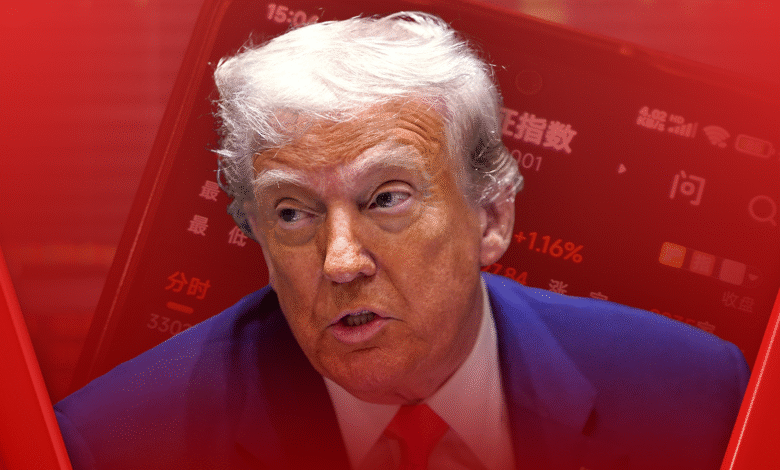Trump Tariffs: New Import Duties Impacting Global Trade

Trump tariffs have taken center stage in discussions about U.S. trade policy, significantly impacting the dynamics of international commerce. Launched as a way to impose reciprocal tariffs, these measures seek to level the playing field with countries that the administration believes have taken advantage of U.S. markets. The introduction of higher import duties affects a range of trading partners, with rates soaring to as much as 50% for some nations, such as Brazil and India. As the U.S. navigates its trade relationships, these tariff rates are reshaping the landscape of international trade and prompting responses from affected countries. Understanding the implications of Trump tariffs is critical for businesses and consumers alike, as they redefine competitive advantages on a global scale.
The recent developments in the realm of tariffs under the Trump administration signal a pivotal shift in America’s approach to economic relations abroad. By implementing these reciprocal tariffs, President Trump aims to modify how foreign goods are taxed upon entering the U.S., enhancing domestic manufacturing competitiveness. With countries like India and Brazil facing escalating duties, there’s a growing debate around the potential benefits and drawbacks of these increased import taxes. As the U.S. grapples with its trade strategy, it becomes crucial to analyze how these changes might affect future negotiations and partnerships in the complex web of global trade. The evolving landscape of tariff implementation holds significant ramifications for both U.S. industries and international market dynamics.
Understanding Trump Tariffs and Their Impact on Global Trade
Trump’s recent implementation of high tariffs, often referred to as ‘reciprocal tariffs,’ has sent shockwaves through the international trade community. These tariffs primarily target goods being exported to the U.S. from countries considered as having taken advantage of America’s previous trade policies. By imposing steep tariff rates—such as 50% on Brazilian and Indian exports—Trump aims to adjust the balance of power in U.S. trade relations. The overall strategy emphasizes the U.S. intent to protect local industries by increasing import duties, thereby making foreign products less competitive in the American market.
The global response to the Trump tariffs has been multifaceted. Various countries are scrambling to negotiate terms to mitigate the financial impact of these tariffs, with Switzerland recently facing a staggering 39% tariff due to failed negotiations. As nations reevaluate their trade strategies, some have already forged successful agreements with the U.S., such as Japan and South Korea, which now enjoy significantly reduced tariff rates of 15%. These developments underline the evolving landscape of U.S. trade policy and the potential repercussions for international trade dynamics.
The Economic Ramifications of Reciprocal Tariffs
Reciprocal tariffs are not just a matter of increased import duties; they can lead to significant economic consequences for both the U.S. and its trading partners. As these tariffs come into effect, businesses that rely on imported goods may find their costs escalating, leading to potential price increases for consumers. For instance, industries that depend on foreign materials for production could see their profit margins shrink, leading to layoffs or decreased investments. Economically, the broader picture paints a potential slowdown if these tariffs continue to escalate, causing uncertainty among investors and businesses alike.
Moreover, the U.S.’s trade policy with reciprocal tariffs could stifle international trade relations. Countries like India and Brazil are already facing tariff rates that threaten their economic stability. As these nations respond with their own tariffs—known as retaliatory tariffs—the cycle of trade restrictions may intensify, hurting global trade. This reciprocal action has the potential to reshape import and export dynamics, prompting countries to rethink their engagement with the U.S. and seek alternative trading partners, further complicating the international economic landscape.
Negotiating Trade Agreements Amid Rising Tariff Rates
As countries grapple with the impact of rising tariff rates, negotiations for trade agreements have become increasingly crucial. The U.S. has managed to secure deals that mitigate some tariff impacts, especially with allies like Japan and South Korea, who now operate under favorable terms with 15% tariffs. The drive to negotiate in the face of imposed tariffs highlights the importance of diplomacy in international trade, where nations must balance protectionism with the need for trade partnerships that benefit their economies.
On the other hand, nations that remain at odds with U.S. policies, such as China and Mexico, find themselves in a precarious position, caught in prolonged negotiations without clear outcomes. The uncertainty surrounding trade dealings can lead to economic instability, where businesses are unable to plan effectively. The failure to reach agreement on tariffs not only affects nations’ economies but can also result in disruptions across global supply chains, emphasizing the importance of proactive trade diplomacy in the current climate of heightened tariffs and international trade tensions.
The Future of U.S. Trade Policy and Tariff Rates
Looking forward, the future of U.S. trade policy remains uncertain amidst ongoing discussions about tariff rates. With the implementation of reciprocal tariffs, President Trump’s administration has sparked debates about the long-term viability of such a strategy. Critics argue that an aggressive tariff regime could lead to trade wars, which may ultimately harm American consumers and businesses. The administration’s next steps will largely shape the trajectory of U.S. trade relations, determining whether America can maintain its position in a globalized economy.
Potentially, the U.S. may reconsider its approach if significant economic fallout occurs as a result of these tariffs. The impact on domestic industries, specifically those reliant on imports, could propel a shift towards more consistent and predictable trade policies. As lawmakers and trade experts assess the evolving situation, the hope is for a balanced approach that considers the needs of local industries while fostering international partnerships. Effectively navigating this complex landscape will be critical for sustaining U.S. economic strength in the competitive global market.
Exploring the Effect of Tariffs on Emerging Economies
Emerging economies often face distinct challenges when confronted with rising tariff rates from a dominant economic force like the U.S. Tariffs can disproportionately affect these nations’ export-driven growth strategies, as they struggle to compete with industries protected by U.S. policies. For example, nations like India and Brazil, which depend on exporting goods to the U.S. market, are now grappling with severely increased tariff rates. As a result, these countries may need to reevaluate their export strategies and focus on diversifying their trading partners.
Additionally, the introduction of heightened tariffs can prompt these emerging economies to seek new markets or enhance domestic production capabilities. This response could lead to innovative strategies that mitigate reliance on a single market, but it may also take time for businesses to adjust. Long-term implications may include shifts in supply chains, greater investment in local industries, and potential economic restructuring, highlighting the complex interplay between U.S. tariffs and global economic evolution.
Analyzing the Domestic Impact of President Trump’s Tariff Policies
The imposition of reciprocal tariffs is not without its domestic repercussions. American consumers could face increased prices on imported goods as businesses pass on the costs associated with high import duties. Industries that rely heavily on foreign components may experience production slowdowns, resulting in job losses and market instability. Economists are increasingly concerned that such policies may lead to broader inflationary pressures, affecting the overall economic growth rate.
On a different note, proponents of Trump’s tariffs argue that these measures protect American jobs by leveling the playing field. By imposing import duties on foreign goods, there may be a surge in demand for domestically produced items, potentially revitalizing certain sectors of the economy. However, this argument is contentious as the long-term viability of such protectionist measures remains to be clarified, suggesting that while short-term benefits may arise, the sustainability of this approach is questionable.
Trump Tariffs: Shifting Dynamics in the Global Economy
Trump’s tariffs exemplify a growing trend of nationalism in trade policy, affecting how countries interact within the global marketplace. As nations grapple with reciprocal tariffs, the balance of trade is increasingly skewed, leading to conversations about equity in international economic engagement. This shift not only impacts those directly involved in trade but also influences geopolitical dynamics as countries seek to align based on economic interests rather than previous alliances.
The resulting trade tensions could redefine how countries negotiate trade agreements going forward. With the rise of tariff rates compelling nations to react strategically, the traditional frameworks of international trade are being challenged. As countries refocus their trade policies in response to U.S. tariffs, collaboration efforts and new alliances may emerge, shaping a new landscape in global economic relations that prioritizes resilience amidst unpredictability.
The Role of Tariff Rates in U.S. Economic Strategy
Tariff rates are a crucial element of U.S. economic strategy, particularly under the current administration. By imposing reciprocal tariffs, the government aims to deter practices that are perceived as unfair in international trade, while also generating revenue through import duties. This approach is intended to stimulate domestic manufacturers and protect American jobs, reflecting a shift towards a more interventionist economic policy that prioritizes national interests over global free trade principles.
However, the implications of such a strategy are complex and far-reaching. While it may temporarily bolster certain sectors, critics raise concerns that it can also lead to retaliatory tariffs from affected countries, potentially igniting trade wars that could destabilize the global economy. Ultimately, understanding the multifaceted impact of tariff rates on both domestic and international levels will be essential for navigating the future of U.S. economic policy.
International Reactions to Trump’s Tariffs and Trade Policies
International reactions to Trump’s tariffs have varied significantly, with some countries quickly seeking to negotiate terms that minimize the financial impacts. For instance, countries like Japan and South Korea have managed to establish agreements that mitigate the effects of tariffs, allowing them to maintain favorable trade relations with the U.S. These negotiations reflect a broader trend as nations adapt to the changing landscape of U.S. trade policy, focusing on forming strategic partnerships to safeguard their economic interests.
Conversely, other nations continue to react defensively, adopting retaliatory tariffs in response to the U.S. measures. This tit-for-tat approach poses risks, as it could escalate into broader trade conflicts that harm both sides’ economies. The challenge for these countries is to balance their response to U.S. tariffs while still protecting their domestic industries, highlighting an intricate dance of negotiations that could define future international trade relations.
Frequently Asked Questions
What are Trump tariffs and how do they affect international trade?
Trump tariffs refer to the import duties imposed by former President Donald Trump on various countries, aimed at protecting U.S. industries and addressing trade imbalances. These tariffs impact international trade by increasing the cost of imports, leading to potential trade disputes and adjustments in global market dynamics.
How do reciprocal tariffs play a role in U.S. trade policy?
Reciprocal tariffs are a strategy within U.S. trade policy, where tariffs are imposed on countries that charge high duties on U.S. goods. These tariffs aim to create a level playing field for American exporters and compel trading partners to negotiate more favorable trade terms.
What were the major impacts of Trump’s tariffs on countries like India and Brazil?
Trump’s tariffs had significant impacts on countries such as India and Brazil, with duties set to 50% on many products. This led to strained trade relations and affected their export economies, particularly in sectors reliant on U.S. markets.
What tariff rates were applied to Switzerland as part of Trump’s tariffs?
Switzerland faced a 39% tariff rate as part of Trump’s tariffs, which caught many by surprise after unsuccessful trade negotiations. This high rate affected Swiss exporters and added pressure on diplomatic relations between the two nations.
How did Trump’s tariffs influence the cost of goods in the U.S.?
Trump’s tariffs increased the cost of imported goods in the U.S., as higher import duties were passed down to consumers. This raised prices on a wide range of products and sparked debates on the overall impact on the U.S. economy and inflation.
Why did Trump implement higher tariff rates on countries like Syria, Laos, and Myanmar?
Trump implemented higher tariff rates on countries like Syria (41%), Laos, and Myanmar (both at 40%) as part of his administration’s strategy to address trade imbalances and protect U.S. industries from perceived unfair trade practices.
What is the significance of Trump’s tariffs in the context of U.S. trade policy?
The significance of Trump’s tariffs lies in their role in reshaping U.S. trade policy towards a protectionist stance, emphasizing bilateral relations and reciprocity, which contrasts with previous multilateral trade agreements and approaches.
How have Trump’s tariffs affected U.S. relationships with trading partners?
Trump’s tariffs have led to strained relationships with several trading partners, resulting in diplomatic tensions and retaliatory tariffs, which complicate negotiations and impact economic cooperation on various fronts.
What are the long-term implications of Trump tariffs for global trade?
The long-term implications of Trump tariffs for global trade may include enduring trade rifts, shifts in supply chains, and an increase in bilateral trade agreements as countries adapt to the new tariff landscape and explore alternate markets.
Have any countries successfully negotiated lower tariff rates under Trump’s policies?
Yes, countries like Japan, South Korea, and members of the European Union were able to negotiate lower tariff rates, now facing 15% tariffs, allowing for continued trade with the U.S. amid the broader tariff increases.
| Country/Region | Tariff Rate (%) | Notes |
|---|---|---|
| Syria | 41 | Highest tariff imposed; aimed at countering trade advantages. |
| Laos | 40 | Significant tariff, part of a broader reciprocal strategy. |
| Myanmar | 40 | Included in the same tariff category as Laos. |
| Switzerland | 39 | Failed to secure a last-minute deal; tariffs took effect immediately. |
| Brazil | 50 | Tariffs took effect, impacting trade heavily. |
| India | 25 (increasing to 50) | Current exports linked to purchases of Russian oil. |
| European Union | 15 | Negotiated agreements reduced tariffs significantly. |
| Japan | 15 | Similar to the EU, managed to negotiate a lower tariff rate. |
| South Korea | 15 | Also negotiated, maintaining lower tariffs. |
| United Kingdom | 10 | Successful negotiation for lower tariffs. |
Summary
Trump tariffs are making a significant impact on international trade dynamics as they come into effect, affecting various U.S. trading partners. The introduction of these tariffs aims to address perceived trade imbalances, with countries like Syria facing the highest rates. As the global economy adjusts, the retaliatory nature of these tariffs raises questions about future trade relations, particularly with key allies like the European Union and Japan. Overall, the implications of the Trump tariffs will continue to unfold as negotiations evolve and economies respond to these changes.



